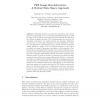Free Online Productivity Tools
i2Speak
i2Symbol
i2OCR
iTex2Img
iWeb2Print
iWeb2Shot
i2Type
iPdf2Split
iPdf2Merge
i2Bopomofo
i2Arabic
i2Style
i2Image
i2PDF
iLatex2Rtf
Sci2ools
IPMI
2005
Springer
2005
Springer
PET Image Reconstruction: A Robust State Space Approach
Statistical iterative reconstruction algorithms have shown improved image quality over conventional nonstatistical methods in PET by using accurate system response models and measurement noise models. Strictly speaking, however, PET measurements, pre-corrected for accidental coincidences, are neither Poisson nor Gaussian distributed and thus do not meet basic assumptions of these algorithms. In addition, the difficulty in determining the proper system response model also greatly affects the quality of the reconstructed images. In this paper, we explore the usage of state space principles for the estimation of activity map in tomographic PET imaging. The proposed strategy formulates the organ activity distribution through tracer kinetics models, and the photon-counting measurements through observation equations, thus makes it possible to unify the dynamic reconstruction problem and static reconstruction problem into a general framework. Further, it coherently treats the uncertainties o...
IPMI 2005 | Medical Imaging | Reconstruction Problem | Response Model | Statistical Iterative Reconstruction |
| Added | 27 Jun 2010 |
| Updated | 27 Jun 2010 |
| Type | Conference |
| Year | 2005 |
| Where | IPMI |
| Authors | Huafeng Liu, Yi Tian, Pengcheng Shi |
Comments (0)

